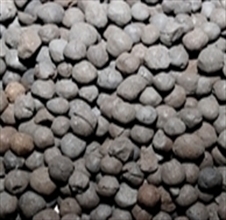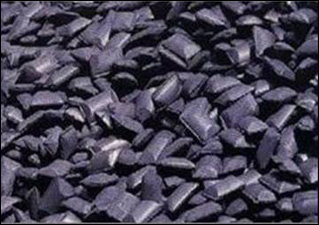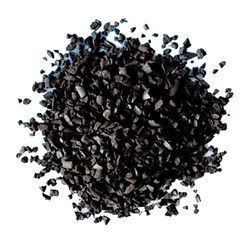Difference between revisions of "Direct Reduced Iron (DRI)"
(→Grades / variations of DRI) |
|||
| Line 9: | Line 9: | ||
__TOC__ | __TOC__ | ||
==Description== | ==Description== | ||
| − | Direct Reduced Iron covers a variety of products generated from the production of iron ore through the process of direct reduction. The name “reduction” is derived from the process whereby iron oxide pellets are passed down through a furnace with counter current flow, (usually a mixture of hydrogen and carbon monoxide). The pellets are heated below melting point of iron. The reaction between the iron ore pellets and the hot gas reduces the oxygen and carbon leaving metallic iron pellets with sponge like structure. (hence also the name | + | Direct Reduced Iron covers a variety of products generated from the production of iron ore through the process of direct reduction. The name “reduction” is derived from the process whereby [[iron oxide]] pellets are passed down through a furnace with counter current flow, (usually a mixture of hydrogen and carbon monoxide). The pellets are heated below melting point of iron. The reaction between the iron ore pellets and the hot gas reduces the oxygen and carbon leaving metallic iron pellets with sponge like structure. (hence also the name “[[sponge iron]]”) |
<br><br> | <br><br> | ||
| − | This process has been developed as an alternative method of iron ore production in order to overcome some difficulties of iron production through conventional blast furnaces. Investment and operating costs for DRI plants are generally less compared to conventional iron ore production. The methodology is particularly applied in countries where the supply of coking coal is limited and where the production facility can be located in close vicinity to the gas source. | + | This process has been developed as an alternative method of iron ore production in order to overcome some difficulties of iron production through conventional blast furnaces. Investment and operating costs for DRI [[plants]] are generally less compared to conventional iron ore production. The methodology is particularly applied in countries where the supply of coking [[coal]] is limited and where the production facility can be located in close vicinity to the gas source. |
<br><br> | <br><br> | ||
| − | DRI is normally shipped in the form of sponge pellets or lumps with diameters varying between 6 to 25 mm. Other DRI products are also shipped as fines or briquettes. Different shipping names are used for the shipment of DRI, including | + | DRI is normally shipped in the form of sponge pellets or lumps with diameters varying between 6 to 25 mm. Other DRI products are also shipped as fines or briquettes. Different shipping names are used for the shipment of DRI, including “[[remet]]”, “[[metallic fines]]” and “[[sponge iron]]”. The iron (fe) content of DRI is relatively high and fluctuates between 90 and 97%, the remainder being carbon and some impurities. |
==Grades / variations of DRI== | ==Grades / variations of DRI== | ||
| − | <i>HBI – Hot briquetted iron </i><br> | + | <i>[[HBI]] – [[Hot briquetted iron]] </i><br> |
This is the DRI shipped in briquettes varying in size between approx. 9 – 13 cms. long, 8 to 10 cms. wide and approx. 1,5 to 5 cms. thick. Compressing the DRI into briquettes takes place at temperatures above 650 dC, hence the name “hot” briquetted. Briquettes are fabricated for the ease of handling and shipment. | This is the DRI shipped in briquettes varying in size between approx. 9 – 13 cms. long, 8 to 10 cms. wide and approx. 1,5 to 5 cms. thick. Compressing the DRI into briquettes takes place at temperatures above 650 dC, hence the name “hot” briquetted. Briquettes are fabricated for the ease of handling and shipment. | ||
<br><br> | <br><br> | ||
[[File:ironbriquettes.jpg]]<br><br> | [[File:ironbriquettes.jpg]]<br><br> | ||
| − | <i>CBI – Cold briquetted iron</i><br> | + | <i>CBI – [[Cold briquetted iron]]</i><br> |
This are briquettes compressed at temperatures below 650 dC and usually contain the more residual products from the manufacturing of ferrous products and materials as DRI. An agent is often used as binder.<br><br> | This are briquettes compressed at temperatures below 650 dC and usually contain the more residual products from the manufacturing of ferrous products and materials as DRI. An agent is often used as binder.<br><br> | ||
<i>DRI fines</i><br> | <i>DRI fines</i><br> | ||
| Line 26: | Line 26: | ||
[[File:ironfines.jpg]] | [[File:ironfines.jpg]] | ||
<br><br> | <br><br> | ||
| − | <i>HBI fines</i><br> | + | <i>[[HBI fines]]</i><br> |
It are usually the fines originating from the production of hot briquettes, although it also may be ordinary DRI fines. (see above).<br> | It are usually the fines originating from the production of hot briquettes, although it also may be ordinary DRI fines. (see above).<br> | ||
| Line 33: | Line 33: | ||
<br><br> | <br><br> | ||
Due to the nature of the sponge like structure of the product, the dissipation of heat is inhibited in bulk parcels of DRI and the heat development can therefore increase very rapidly. | Due to the nature of the sponge like structure of the product, the dissipation of heat is inhibited in bulk parcels of DRI and the heat development can therefore increase very rapidly. | ||
| − | When in contact with water, the hot DRI can cause a chemical reaction resulting in the formation of hydrogen, which is a highly explosive gas. This production of hydrogen is the most dangerous property of DRI and has led to several fatal explosions. | + | When in [[contact]] with water, the hot DRI can cause a chemical reaction resulting in the formation of hydrogen, which is a highly explosive gas. This production of hydrogen is the most dangerous property of DRI and has led to several fatal explosions. |
<br><br> | <br><br> | ||
| − | There is a variation of risk depending on the nature and form of DRI shipped. Hot briquetted iron is generally considered to have the least risks, also because the briquettes are coated with sodium silicate or allowed to form a layer or iron oxide, which inhibits the oxidation process during transit. DRI fines and cold briquetted DRI have a higher risk profile. | + | There is a variation of risk depending on the nature and form of DRI shipped. [[Hot briquetted iron]] is generally considered to have the least risks, also because the briquettes are coated with sodium silicate or allowed to form a layer or [[iron oxide]], which inhibits the oxidation process during transit. DRI fines and cold briquetted DRI have a higher risk profile. |
<br><br> | <br><br> | ||
Apart from the general provisions for carrying DRI, there are type-specific requirements in the relevant IMSBC Code for carrying either briquettes (A), lumps, pellets and cold-moulded briquettes (B) and fines / by products (C). These requirements are very detailed, for which reference is made to the relevant sections in the applicable IMO Code for hazardous bulk cargoes (IMSBC). | Apart from the general provisions for carrying DRI, there are type-specific requirements in the relevant IMSBC Code for carrying either briquettes (A), lumps, pellets and cold-moulded briquettes (B) and fines / by products (C). These requirements are very detailed, for which reference is made to the relevant sections in the applicable IMO Code for hazardous bulk cargoes (IMSBC). | ||
Revision as of 10:53, 15 April 2013
| Infobox on Direct Reduced Iron (DRI) | |
|---|---|
| Example of Direct Reduced Iron (DRI) |  |
| Facts | |
| Origin | World wide |
| Stowage factor (in m3/t) |
|
| Humidity / moisture |
|
| Ventilation |
|
| Risk factors |
|
Direct Reduced Iron (DRI)
Contents
Description
Direct Reduced Iron covers a variety of products generated from the production of iron ore through the process of direct reduction. The name “reduction” is derived from the process whereby iron oxide pellets are passed down through a furnace with counter current flow, (usually a mixture of hydrogen and carbon monoxide). The pellets are heated below melting point of iron. The reaction between the iron ore pellets and the hot gas reduces the oxygen and carbon leaving metallic iron pellets with sponge like structure. (hence also the name “sponge iron”)
This process has been developed as an alternative method of iron ore production in order to overcome some difficulties of iron production through conventional blast furnaces. Investment and operating costs for DRI plants are generally less compared to conventional iron ore production. The methodology is particularly applied in countries where the supply of coking coal is limited and where the production facility can be located in close vicinity to the gas source.
DRI is normally shipped in the form of sponge pellets or lumps with diameters varying between 6 to 25 mm. Other DRI products are also shipped as fines or briquettes. Different shipping names are used for the shipment of DRI, including “remet”, “metallic fines” and “sponge iron”. The iron (fe) content of DRI is relatively high and fluctuates between 90 and 97%, the remainder being carbon and some impurities.
Grades / variations of DRI
HBI – Hot briquetted iron
This is the DRI shipped in briquettes varying in size between approx. 9 – 13 cms. long, 8 to 10 cms. wide and approx. 1,5 to 5 cms. thick. Compressing the DRI into briquettes takes place at temperatures above 650 dC, hence the name “hot” briquetted. Briquettes are fabricated for the ease of handling and shipment.

CBI – Cold briquetted iron
This are briquettes compressed at temperatures below 650 dC and usually contain the more residual products from the manufacturing of ferrous products and materials as DRI. An agent is often used as binder.
DRI fines
This product consists of DRI particles with a size of 4 mm. diameter or less. It is a by-product from the manufacturing of DRI pellets or briquettes.

HBI fines
It are usually the fines originating from the production of hot briquettes, although it also may be ordinary DRI fines. (see above).
Risk factors
Irrespective of the form in which it is shipped, DRI (like any other steel product) is susceptible to rust development, in the presence of oxygen. The rate of oxidation is, to an extent, dependant on the moisture content of the DRI and the atmosphere, in which DRI is stored. This oxidation process is exothermic and generates heat. In bulk shipments this heat generation can become very significant, particularly when the water contains chlorides from seawater. It is therefore of the utmost importance that prior to carrying DRI the risks of seawateringress (hatchcovers / ballast tanks) are very well considered and actions are put in place to avoid such from happening.
Due to the nature of the sponge like structure of the product, the dissipation of heat is inhibited in bulk parcels of DRI and the heat development can therefore increase very rapidly.
When in contact with water, the hot DRI can cause a chemical reaction resulting in the formation of hydrogen, which is a highly explosive gas. This production of hydrogen is the most dangerous property of DRI and has led to several fatal explosions.
There is a variation of risk depending on the nature and form of DRI shipped. Hot briquetted iron is generally considered to have the least risks, also because the briquettes are coated with sodium silicate or allowed to form a layer or iron oxide, which inhibits the oxidation process during transit. DRI fines and cold briquetted DRI have a higher risk profile.
Apart from the general provisions for carrying DRI, there are type-specific requirements in the relevant IMSBC Code for carrying either briquettes (A), lumps, pellets and cold-moulded briquettes (B) and fines / by products (C). These requirements are very detailed, for which reference is made to the relevant sections in the applicable IMO Code for hazardous bulk cargoes (IMSBC).











